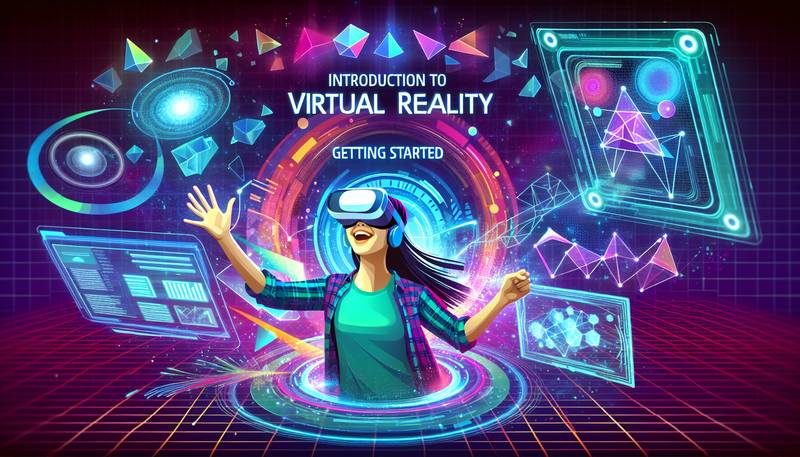Introduction to Virtual Reality (VR): Getting Started

Have you ever wanted to climb Mount Everest, explore the depths of the ocean, or walk on the surface of Mars, all from the comfort of your living room? Welcome to the world of Virtual Reality, a technology that’s not just a fad but a gateway to experiences beyond your wildest dreams. VR is immersive, interactive, and incredibly versatile, and it's becoming more accessible every day. Whether you’re a gamer looking to up your play, a professional seeking cutting-edge training tools, or just someone who loves to be at the forefront of technology, VR has something for everyone. In this comprehensive guide, we'll walk you through everything you need to know to get started with VR. Fasten your seatbelts; it’s going to be an exciting ride!
What is Virtual Reality?
Virtual Reality, often abbreviated as VR, is a simulated environment created using computer technology. It’s a three-dimensional, computer-generated world that can be explored and interacted with by a person. That person becomes part of this virtually created space and can manipulate objects or perform a series of actions. Imagine donning a headset and instantly being transported to a virtual world where every sense is engaged. You look around in 360 degrees, and the environment responds as if you were actually there. You can wander amongst dinosaurs, learn in a virtual classroom or fight zombies in a post-apocalyptic wasteland. The possibilities are nearly endless.
A Brief History of VR
VR may seem like a modern innovation, but its foundations can be traced back to the 1950s and ‘60s with the development of the first flight simulators and the Sensorama, an early VR machine. By the 1980s, VR was being used for NASA training, and in the 1990s, VR arcades sprung up, even though the technology was still bulky and quite expensive. However, VR was not widely adopted due to limitations in technology and high costs. Fast forward a couple of decades, advancements in computing power, graphics technology, and motion sensors have catapulted VR into the mainstream. Modern VR came into prominence in 2012 with the introduction of the Oculus Rift, a consumer-oriented VR headset. With subsequent advances and the introduction of competitors, VR technology has become more affordable and prevalent, finding its way into diverse sectors including entertainment, education, healthcare, and more.
Choosing the Right VR Headset
Picking the right VR headset is crucial for an optimal VR experience. Today's market is rich with options, but navigating this sea of high-tech headgear can be overwhelming. VR headsets can be broadly categorized into three types: Tethered, Standalone, and Smartphone headsets.Tethered headsets offer the most immersive experiences, delivering high-quality visuals and powerful tracking. They are connected via cable to a PC or gaming console, which does the heavy lifting. The Oculus Rift S and HTC Vive are prime examples of tethered headsets. These devices come equipped with sophisticated sensors and cameras that track your movement and translate it into the virtual environment. However, the downside is the lack of mobility due to the cables.Standalone headsets, like the Oculus Quest 2, provide a middle ground. They're wireless and house all necessary components within the headset itself. This means you don't need an external device, granting you full freedom of movement. They tend to be more user-friendly but may not offer the same high-powered performance as tethered models.Smartphone headsets are the most accessible VR devices. They use your smartphone's screen and processing power to deliver a VR experience. Google Cardboard and Samsung Gear VR fall into this category. They're a great option for VR newbies or those on a strict budget.When choosing a headset, consider factors such as comfort, resolution, field of view, refresh rate, tracking capabilities, and software availability. It's also crucial to make sure your computer or smartphone is capable of handling the VR headset you choose.
Setting Up Your VR Space
Now that you've chosen your headset, it's time to set up the perfect VR space to ensure safety and comfort during your sessions. First, you'll need a clear area with enough room to move around. Depending on the system, you might need different amounts of space. For example, high-end systems like the Valve Index or HTC Vive require a space that's at least 6.5 by 5 feet. Remove any obstacles that you might stumble upon and make sure the floor is not slippery. Some VR enthusiasts prefer using mats or carpets to not only protect the equipment but to have a tactile boundary of their play area. It's essential to have good lighting, not too bright nor too dark, to help the cameras or sensors track your movement accurately.Additionally, you should consider the placement of your PC or console. It needs to be close enough to connect to the headset without the cables stretching across the room creating a tripping hazard. For the most immersive experience, investing in a dedicated VR room could be ideal. This doesn't only expand your play area but also allows you to customize the environment for the ultimate VR experience.
Understanding VR Software
Navigating through the world of VR software can be as exhilarating as exploring the virtual worlds it opens up. VR software includes the applications and games that run on your VR device, and they come in various genres and formats to suit different tastes and interests. From heart-pumping action games to serene meditation landscapes, the content is as varied as it is abundant.Before you can dive in, however, you'll need to understand how to get these applications onto your device. For PC-based VR systems, this typically involves downloading a VR software platform like SteamVR, Oculus Home, or Viveport. These platforms act as both a store and a library, where you can purchase, download, and launch VR experiences. Standalone VR headsets usually come with their own library of apps, like the Oculus Quest Store, and many offer easy, wireless downloading directly from the device.Once you've set up your platform, take your time exploring the vast array of available VR content. Look for 'VR' or 'Virtual Reality' tags to filter out non-VR games and applications. It's also worth checking user reviews and ratings to gauge the quality and performance of the content. Remember to check the system requirements for each VR application, as some may need more computing power than others. This will ensure that your software is not just compatible, but also runs smoothly on your headset for an optimal experience.
Getting Started with VR Experiences
With your headset up and chosen software platform ready, it's time to start experiencing VR. If you're new to virtual reality, you might want to start with introductory experiences that can help you get used to moving around and interacting in a virtual space. Many VR platforms offer free demos or trials that are designed specifically for first-time users. These experiences are often shorter and less complex, giving you a chance to adjust to VR's unique sensations without feeling overwhelmed.For gaming enthusiasts, VR offers a revolutionized way to play. From first-person shooters that transport you into the heart of the action to puzzle games that involve full body movement, there's a VR game for everyone. For those more interested in the educational or training potential of VR, there are VR experiences crafted to simulate real-world scenarios, such as public speaking, medical procedures, or mechanical repairs.Remember that VR can be intense, and motion sickness, known as VR sickness, is a common issue for beginners. To prevent this, start with experiences that have less movement and gradually work your way up as you become more comfortable. Always take breaks if you start feeling dizzy or disoriented. Over time, you will likely develop a tolerance and be able to enjoy more dynamic VR experiences.
Enhancing Your VR Experience
As you become more familiar with VR, you might feel the urge to enhance your experience with additional accessories or equipment. This could be anything from a set of VR controllers that offer more precise and varied interactions, to a pair of high-quality headphones that provide spatial audio for an even more immersive auditory experience.Controllers are an essential accessory that can greatly enhance the quality of your VR experience. They allow for natural and intuitive interaction within the virtual world, often mirroring actual hand movements. Some advanced controllers are equipped with haptic feedback, giving you tactile sensations that simulate the feel of objects and environments in the virtual space.Other interesting add-ons include treadmills and motion platforms which simulate walking or running within VR without actually moving in the space, or full body suits that give feedback in response to in-game actions for a truly full-body experience.Indeed, the world of VR accessories is ever-expanding, and these enhancements can bring you closer to a truly authentic virtual experience. Just remember to always weigh the costs and benefits, and consider the compatibility with your existing setup.
Concluding Thoughts
As we wrap up our journey into the depths of Virtual Reality, it's clear that VR is more than just an escape from reality; it's an expansion of it. Whether you've decided to climb distant mountains, expand your work skills, or battle it out in digital arenas, the world of virtual reality holds endless potential. With the right headset, a comfortable play area, and a pinch of curiosity, you're well on your way to experiencing the wonders of these alternate realities.As VR technology continues to evolve and become more advanced, who knows what the future may hold? Perhaps one day VR will be as common in homes as televisions are today. But until then, enjoy exploring these new worlds, learning new skills, and pushing the boundaries of what's possible. The virtual world awaits your arrival, ready for you to make your mark. Dive in and let your virtual adventure begin!


